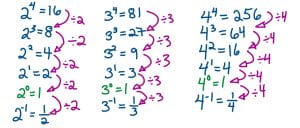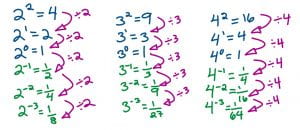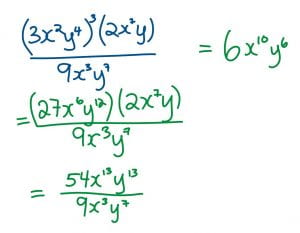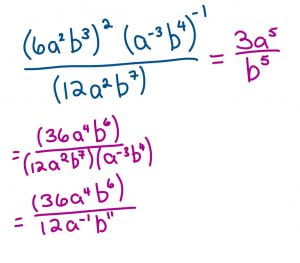Tag: ExponentsHUBBARD2019
Everything I Know About Exponents
- Describe how powers represent repeated multiplication.
The exponent represents the number of times you multiply the base by itself. For example, 43 means 4 x 4 x 4.
- Demonstrate the difference between two given powers in which the exponent and the base are interchanged by using repeated multiplication.
One way to tell the difference between powers with interchangeable bases and exponents is by writing them as repeated multiplications. 34 and 43 will have different answers. 34 is the same as 3 x 3 x 3 x 3 which equals 81, whereas 43 is the same as 4 x 4 x 4 which equals 64.
- Explain the role of parentheses in powers by evaluating a given set of powers.
Parentheses are very important in powers. The difference has to do with whether or not the exponent applies to the coefficient. For example, -34, (-3)4, and (-34) don’t all have the same answer. In this case, -1 is the coefficient. When there aren’t any parentheses, the exponent only applies to the base: -1 x 3 x 3 x 3 x 3 = -81. When the parentheses are around everything but the exponent, consider everything inside the parentheses the base, and apply the exponent to the whole thing: (-3) (-3) (-3) (-3) = 81. When the parentheses are around everything, you do the same thing as when there are no parentheses, but keep the parentheses around the whole power because it usually has to do with the rest of the equation: (-1 x 3 x 3 x 3 x 3 = -81)
- Explain the exponent laws for raising a product and quotient to and exponent.
Raising a product and quotient to an exponent is basically how you apply the exponent to what comes before it. If there is a multiplication in parentheses and an exponent after it, you put the exponent on both or all factors. It’s the same with division, where you out the exponent on both the dividend and divisor. For example: (2 x 3)3 is the same as 23 x 33 . There is also the power law, where you already have a power, but it’s in parentheses with an exponent on the outside, and in that case, you multiply the exponents together and keep the base.
- Use patterns to show that a power with an exponent of zero is equal to one.
Here are examples of why a power with an exponent of zero is always 1 (unless the base is zero):
- Use patterns to explain the negative exponent law.
To explain the negative exponent law, it’s just a continuation of the pattern for #10.
All of the answers are the reciprocals and they are all positive.
- Identify the error in a simplification of an expression involving powers.
This is an example of a simplification of an expression with some errors.
If this was the simplification
There were two main errors:
- They multiplied 3 x 3 instead of calculating 33 in the first group of parentheses in the numerator ignoring the power law.
- In the numerator, the person multiplied the exponents of x and y instead of adding them which is the product law.
I think that both of those mistakes are quite common.
This is the correct way of simplifying the expression:
- Determine the sum and difference of two powers.
The sum:
34 + 62
= 81 + 36
= 117
The difference:
34 – 62
= 81 – 36
= 45
- Use powers to solve problems (measurement problems)
This is an example of how to use powers to solve a measurement problem:
- Apply the order of operations on expressions with powers involving negative exponents and variable bases.
This is the link to my partner Stella’s blog: Stella’s Blog
Reflection:
 Loading...
Loading...
Riverside Links
My Tags
#2019SH9BlocC #ADL19sollutionfluency #aquatic field studies #circletalkC #communicationcc #creativethinkingcc #criticalthinkingcc #invertebrate studies #magnetpoetry #MathArtPahlevanlu #personalawarenesscc #poetrytalks #spheres #waterfilterchallenge ADL19infofluency connection2020 documentaryposter ExponentsHUBBARD2019 flipstoryC footprint2019 indigenouspodcast mediaresearch mindmapeng11p2 newmediaintro o #creativethinkingcc o #criticalthinkingcc partnerppC rswordcloud silverliningc silverlining c technologyselfportrait typesofwriting writingtypes-
Recent Posts





